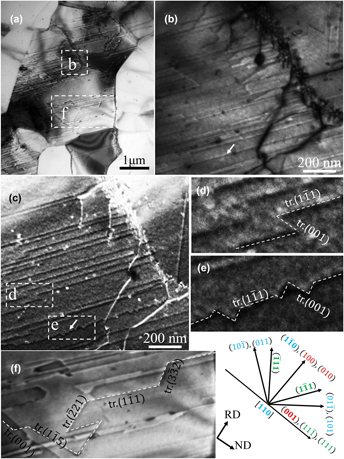Crossref Citations
This article has been cited by the following publications. This list is generated based on data provided by
Crossref.
Yan, Jiawei
Li, Wei
Liu, Haiting
and
Shen, Yao
2019.
Reversion of sub-boundaries into dense dislocations in aluminum by electric pulsing treatment.
Scripta Materialia,
Vol. 167,
Issue. ,
p.
86.
Ba, Xin
Zhou, Mengcheng
Zhang, Xinfang
and
Wang, Hui
2020.
Manipulating Dislocations Using Electric Field to Repair Embrittlement Damage.
ISIJ International,
Vol. 60,
Issue. 8,
p.
1803.
Orallo, Ana
Trinidad, Javier
Galdos, Lander
de Argandoña, Eneko Sáenz
and
Mendiguren, Joseba
2020.
Aluminum Springback Reduction by Post-forming Electric Pulses.
Procedia Manufacturing,
Vol. 47,
Issue. ,
p.
1387.
Yan, Jiawei
Liu, Guisen
Zhao, Xiaofeng
and
Shen, Yao
2021.
Rapid homogeneous precipitation of nano-sized Si in Al–1%Si alloy by electric pulses.
Materials Science and Technology,
Vol. 37,
Issue. 2,
p.
144.
Jiang, Bo
Zhang, Dongdong
Xu, Hong
Liu, Yongbing
Cao, Zhanyi
and
Yang, Xiaohong
2021.
Excellent Ductility in the Extruded AZ61 Magnesium Alloy Tube Induced by Electropulsing Treatment during Tension.
Metals,
Vol. 11,
Issue. 5,
p.
813.
Xu, Hong
Zou, Yu-Jie
Huang, Yu
Ma, Pin-Kui
Guo, Zhi-Peng
Zhou, You
and
Wang, Yu-Peng
2021.
Enhanced Electroplasticity through Room-Temperature Dynamic Recrystallization in a Mg-3Al-1Sn-1Zn Alloy.
Materials,
Vol. 14,
Issue. 13,
p.
3739.
Zhao, Shiteng
Zhang, Ruopeng
Chong, Yan
Li, Xiaoqing
Abu-Odeh, Anas
Rothchild, Eric
Chrzan, Daryl C.
Asta, Mark
Morris, J. W.
and
Minor, Andrew M.
2021.
Defect reconfiguration in a Ti–Al alloy via electroplasticity.
Nature Materials,
Vol. 20,
Issue. 4,
p.
468.
Liu, Wenqi
Otegi, Nagore
Orallo, Ana
Barrenetxea, Manex
Aizpuru, Iosu
Lian, Junhe
and
Mendiguren, Joseba
2022.
Post-forming, electro-plastic effect internal stress reduction in AA5754 aluminium alloy.
Materials Science and Engineering: A,
Vol. 852,
Issue. ,
p.
143686.
Jeong, Kyeongjae
Jin, Sung-Woo
Kang, Sung-Gyu
Park, Ju-Won
Jeong, Hye-Jin
Hong, Sung-Tae
Cho, Seung Hyun
Kim, Moon-Jo
and
Han, Heung Nam
2022.
Athermally enhanced recrystallization kinetics of ultra-low carbon steel via electric current treatment.
Acta Materialia,
Vol. 232,
Issue. ,
p.
117925.
He, Guangyu
Liu, Zhiyi
and
Liu, Fei
2022.
Effects of dislocation slip behaviour and second-phase particles on hot rolled texture of an Al-Cu-Mg alloy with a high Cu/Mg ratio.
Journal of Alloys and Compounds,
Vol. 911,
Issue. ,
p.
165085.
Deng, Zhike
Li, Xiaopei
Wang, Shengzhan
Li, Xiaohui
Chen, Dexin
and
Xiao, Xiufeng
2022.
Texture tailoring of a cold-rolled Mg-Zn-Gd alloy by electropulse treatment: The effect of electropulse and Gd element.
Materials Characterization,
Vol. 190,
Issue. ,
p.
112046.
Zhou, Yicheng
Yang, Bing
and
Zhang, Guodong
2022.
Microstructure and Mechanical Properties of Cocrfemnni/Wc Plasma Deposited Layer after the Synergistic Treatment of Pulsed Current and Joule Heat.
SSRN Electronic Journal ,
Liu, Fei
Liu, Zhiyi
and
He, Guangyu
2022.
Effect of cold rolling on microstructure and hardness of annealed Al–Cu–Mg alloy.
Archives of Civil and Mechanical Engineering,
Vol. 22,
Issue. 2,
Chen, Wanji
Xu, Jie
Ding, Chaogang
Shan, Debin
Guo, Bin
and
Langdon, T.G.
2022.
Fracture Mechanism of Electrically-Assisted Micro-Tension in Nanostructured Titanium Using Synchrotron Radiation X-Ray Tomography.
SSRN Electronic Journal ,
Chen, Wanji
Xu, Jie
Ding, Chaogang
Shan, Debin
Guo, Bin
and
Langdon, Terence G.
2023.
Fracture mechanism of electrically-assisted micro-tension in nanostructured titanium using synchrotron radiation X-ray tomography.
Scripta Materialia,
Vol. 222,
Issue. ,
p.
114997.
Wang, Kuizhao
Zhang, Cunsheng
Cheng, Zinan
Meng, Zijie
Chen, Liang
and
Zhao, Guoqun
2023.
Deformation mechanism of as-extruded Al–Cu–Li alloy with heterogeneous fiber structure.
Materials & Design,
Vol. 229,
Issue. ,
p.
111872.
Song, Yanli
Wu, Yuhang
Lu, Jue
Mei, Manlin
Xie, Lechun
and
Hao, Chuanchuan
2023.
Promoting Dynamic Recrystallization of Al-Zn-Mg-Cu Alloy via Electroshock Treatment.
Metals,
Vol. 13,
Issue. 5,
p.
944.
Xue, Ling
Jiang, Junda
Yang, Yi
Xu, Gaolei
Liao, Chengzhi
Liu, Jian
and
Wu, Mingxia
2023.
An eco-friendly electric pulse treatment process for improving the microstructure and properties of cold-rolled pure copper sheet.
Materials Research Express,
Vol. 10,
Issue. 6,
p.
066513.
Wang, Xiang
Zhou, Baoxue
Huang, Hua
Niu, Jialin
Guan, Shaokang
and
Yuan, Guangyin
2024.
Extraordinary ductility enhancement of Mg-Nd-Zn-Zr alloy achieved by electropulsing treatment.
Journal of Magnesium and Alloys,
Vol. 12,
Issue. 11,
p.
4481.
Kim, Moon-Jo
Bui-Thi, Tu-Anh
Kang, Sung-Gyu
Hong, Sung-Tae
and
Nam Han, Heung
2024.
Electric current-induced phenomena in metallic materials.
Current Opinion in Solid State and Materials Science,
Vol. 32,
Issue. ,
p.
101190.



